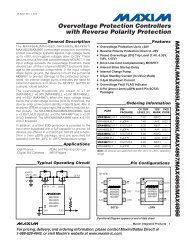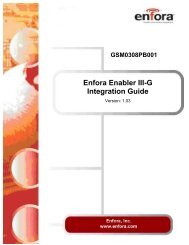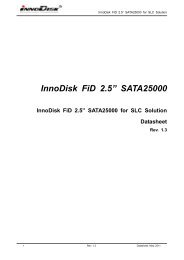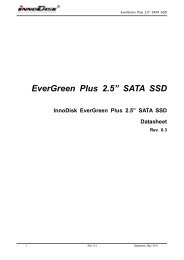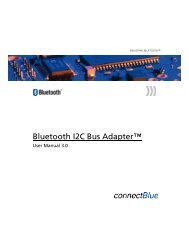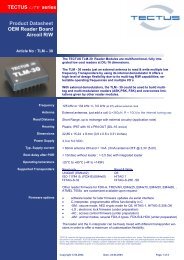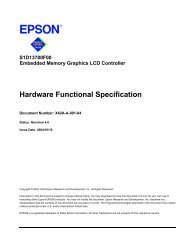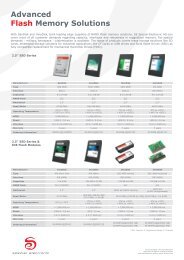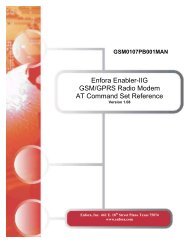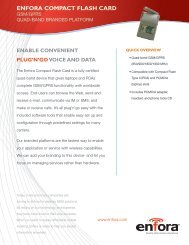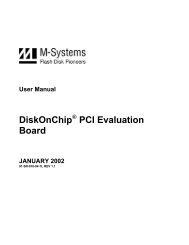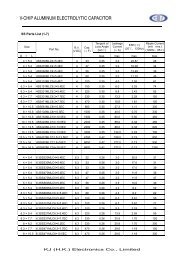AT+i Programmer's Manual - SE Spezial-Electronic AG
AT+i Programmer's Manual - SE Spezial-Electronic AG
AT+i Programmer's Manual - SE Spezial-Electronic AG
Create successful ePaper yourself
Turn your PDF publications into a flip-book with our unique Google optimized e-Paper software.
27.3 RAS Theory of Operation<br />
iChip RAS Server<br />
When a remote client dials into iChip, the modem RING strings are transferred by iChip<br />
(which defaults to transparent mode) to the host. When the RAS feature is enabled (RAU<br />
contains a value), iChip picks up the line and negotiates a PPP connection by issuing the<br />
ATA (modem) command after RAR RING strings have been received.<br />
If the host chooses to manage a direct (modem-to-modem) data connection, it can pick up<br />
the line before RAR RING strings have arrived by issuing the ATA modem command.<br />
During RAS PPP negotiations, iChip will replies only to (+++) (escape sequence) and<br />
<strong>AT+i</strong>RPn commands. Specifically, iChip replies ―Connecting as RAS‖ to the <strong>AT+i</strong>RP2<br />
(iChip status) command. The escape sequence can be used to abort the RAS session at<br />
any time. The <strong>AT+i</strong>RP2 command is the only means for the host processor to determine<br />
that a PPP session is in progress. iChip manages the RAS protocol internally and does not<br />
transfer any information to the host. Any other commands received from the host are<br />
disregarded by iChip.<br />
Once the PPP connection has been fully negotiated and established, iChip responds to all<br />
<strong>AT+i</strong> commands as when it is online. Specifically, iChip replies ―RAS Connected‖ to the<br />
<strong>AT+i</strong>RP2 command.<br />
As part of the PPP negotiation, iChip assigns itself the default IP 192.168.0.1 and<br />
allocates 192.168.0.2 as the client IP. However, if the client requests a specific IP, iChip<br />
always grants the client‘s request and uses the client‘s IP minus 1 as its own IP.<br />
The following restriction to the minus 1 rule applies: If the IP requested by the client<br />
minus 1 is an IP address that ends with 0x00 or 0x255 as the last nibble, iChip assigns<br />
itself with the client‘s IP plus 1 instead of minus 1. This is done to assure that the IP that<br />
iChip assigns itself never violates the rule that defines that a network or host IP segment<br />
may not be all binary 1‘s, nor all binary 0‘s.<br />
After a RAS PPP connection is established, iChip automatically activates the internal web<br />
server, if the AWS parameter is set to a non-zero value. Thus, the remote client can<br />
browse iChip‘s website.<br />
27.3.1 Auto PPP RAS Mode<br />
iChip allows combining RAS and direct modem-to-modem communication sessions. A<br />
special mode, named Auto PPP RAS, supports dialing into the iChip with a PPP dialer or<br />
a regular modem.<br />
Auto PPP RAS mode is enabled by enabling RAS mode and adding a +100 offset to the<br />
RAR parameter, where [-100] determines the number of RINGS after which iChip<br />
automatically picks up the line and negotiates a PPP connection. The host processor can<br />
instruct the modem to pick up the line beforehand by issuing the ATA (modem)<br />
command or by setting the modem to auto-answer after less than [-100] RING<br />
strings. This is normally done in order to manage a direct modem-to-modem (non-PPP)<br />
communication session.<br />
When iChip is in the Auto PPP RAS mode, it monitors the data stream following the<br />
modem CONNECT line. If the first character transmitted by the remote end is (~) (0x7E),



